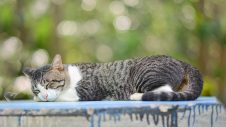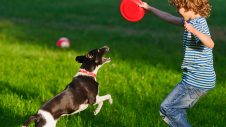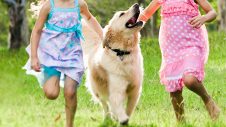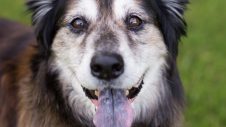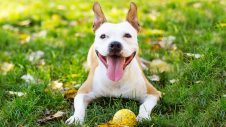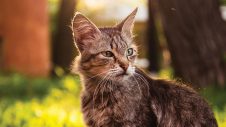The beginning of the year is often a good time to take stock of your pet’s health – especially regarding their weight, diet and exercise levels. While their owners might decide to hit the gym or try the latest fad diet to recover from any excesses over Christmas, it is not always as easy for their animal companions.
Did you know that over 40% of Australian pets are overweight and at high risk of health problems such as arthritis, diabetes, heart and lung disease? Subtle signs, like poor coat quality or skin problems, may be a symptom of obesity as pets may not be able to groom themselves.
We have little control over some contributing factors of obesity, such as breed, genetics, and age. However, there are other factors that we can control, such as how much we feed our pets, their exercise levels, and providing our pets with a superior, complete, and balanced diet.
These tips will help you determine if your pet has a weight problem and suggest some simple ways to tackle it.
Why is pet obesity a problem?
Like their owners, Australian pets are facing a growing problem with obesity. Indeed, almost half of the dogs and one-third of the cats in Australia are overweight or, worse, obese. Being overweight has a dramatic effect on the health of your dog or cat – and can even reduce their life expectancy. There are strong associations that overweight animals have increased risks of heat stroke (especially during summer), as well as diabetes, mobility problems such as arthritis, and even cancer, just to name a few. Studies have shown that overweight pets can have their lives reduced by as much as two years.
Keeping your dog healthy
How to tell if your dog is overweight
Since breeds can vary, it’s always a good idea to talk to your vet about your dog’s weight and body condition during one of your regular health check-ups – and get an indication of a healthy weight range. There are some visual indicators of your pet’s ideal body condition, which your Greencross Vet can advise you on. Generally, you should be able to easily feel your dog’s ribs, with a slight fat coverage over them. If you’re looking at them from above, they should have an ‘hourglass’ figure where there’s a tuck between their ribs and pelvis. Spayed (desexed) females are often at a higher risk of being overweight, as are dogs whose owners are also on the cuddlier side.
Some ‘weighty’ questions to consider and help identify if your pet has a weight problem:
- Does your pet have constant access to food or snacks?
- Does your pet eat table scraps or leftovers?
- Do you ever skip playing or exercising with your pet?
- Do you have difficulty feeling your pet’s ribs?
- Is there little or no waistline?
Your dog’s diet
It can be very easy to overfeed a dog. Dogs generally like to please their owners and will usually attempt to eat all food put in front of them, regardless of their hunger. This can mean many owners get into a vicious cycle that involves overfeeding their pets, with those same pets eating everything in their bowl and the owners assuming they are hungry and feeding them even more. There are many pet food products available to cater to different dietary requirements, as well as slow-feeding bowls to discourage dogs from eating too quickly. While treats can be useful for training and behaviour purposes, it is important not to give your dog treats too frequently. Reserve treats for rewarding good behaviour, and choose a reputable dog food brand that is complete and balanced. Most pet food packaging will include recommended amounts aligned to your dog’s ideal weight. Again, your vet can advise you on the best brand for your dog.
Exercising your dog
Diet is only part of the equation when it comes to maintaining a healthy weight for your dog. It is also important to give your dog regular exercise, especially walking. Many dogs need a regular walk twice a day. If this is difficult for your family, their daily food intake needs to be limited accordingly. It is important to match your dog’s incoming calories with the energy they are burning off. Some dogs enjoy games such as retrieving balls or frisbees; however, it is important to ensure these games are conducted safely so your dog doesn’t injure itself.
Keeping your cat healthy
Weight management for cats
Cats, especially those indoors, often have challenges in maintaining an ideal weight. Ensure you are feeding your cat the recommended amounts of food, and check the packet if you are unsure. If your cat has a tendency to roam, make sure they are not getting fed by neighbours – outdoor cats are notorious for accepting multiple meals from different households. Signs that your cat might be overweight are similar to those in dogs – reduced ability to feel the ribs and loss of the ‘hourglass’ shape. Sometimes, you can see a ‘sagging’ towards the underside of cats. Talk to your Greencross veterinarian about your cat’s weight and body condition to ensure they are on track. If your cat needs to lose weight, it is probably best to start with diet modification and be aware that sometimes it can be a slow process. Regular weigh-ins at the vet can help keep you on track.
Exercising your cat
While it is possible to take your cat on regular walks, most cats like to walk freely. Cats should be encouraged to exercise, even if they are indoors. Equipment such as cat gyms and tunnels can help keep your cat fit and healthy, as well as giving them toys such as balls to play with. If your yard is secure, encourage your cats to explore the outdoors with a variety of climbing apparatuses.
For more information about how to keep your pet’s weight under control, book your pet for a regular weigh-in and assessment with your local Greencross Vets team.

 Greencross Vets
Greencross Vets 